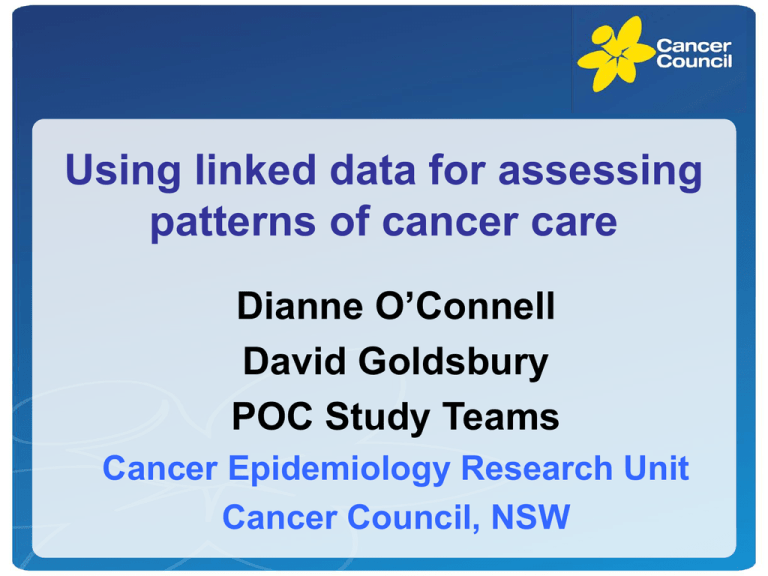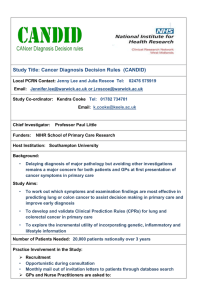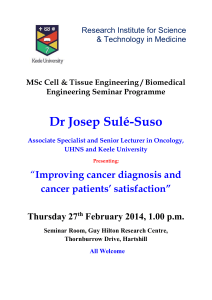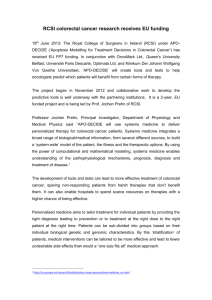Dianne O'Connell - Record Linkage.ppt
advertisement

Using linked data for assessing patterns of cancer care Dianne O’Connell David Goldsbury POC Study Teams Cancer Epidemiology Research Unit Cancer Council, NSW Overview • Patterns of cancer care studies • Use of linked records • Validation of linked data sets for patterns of care • Possible analyses of linked data sets • Other research using linked records Patterns of Cancer Care Studies • • • • Describe treatment patterns Compare management with guidelines Assess accessibility to care Identify inequities in care Methods • Ad hoc data collections • Clinical Cancer Registries • Record linkage of routinely collected (administrative) data sets Patterns of cancer care studies • Lung, colorectal, prostate cancers in NSW • Methods – Identify patients through population-based NSW Central Cancer Registry (CCR) – Consent from doctors and patients to pass details on to researchers – Informed consent from patients Patterns of care studies – methods • Questionnaires from treating doctors – Find correct doctor – Obtain treatment and referral information – Field collection where necessary – Response rates • colorectal 88-97% • lung 62% • prostate 64% • Participants diagnosed 1999-2002 Patterns of care studies - limitations • • • • • Resource intensive Consent rates from patients Response rates from doctors Relies on doctors’ clinical notes Data represents a snapshot and soon out of date Is there an easier way? • Cancer registry information in Australia does not include treatment • Hospital discharge records will not capture or identify all relevant cases of cancer • Combined, they may be more useful Use of administrative datasets (1) • NSW Central Cancer Registry (CCR) • Population-based – Cancer is notifiable due to Public Health Act – Hospitals, pathology labs, radiation oncologists, nursing homes, deaths Use of administrative datasets (2) • NSW Admitted Patient Data Collection (APDC) – All hospital separations (discharges, transfers, deaths) – All NSW public and private hospitals and day procedure centres Record linkage NSW Central Cancer Registry 1993 - 2002 Admitted Patient Data Collection July 1992 - Jun 2003 • Linked by NSW Health in 2005 • 86% of CCR cases linked to APDC • Procedures & comorbidities identified in APDC records Variables • CCR – sex, age at diagnosis, health area and SLA of residence, date of diagnosis, best method of diagnosis, spread of disease at diagnosis, cause of death (if dead), survival time • APDC – sex, age, health area and SLA of residence, health area of treatment, type of hospital, date of admission, date of separation, procedures, principal diagnosis, additional diagnoses, health insurance status on admission Analysis issues • One record per hospital episode, each with multiple procedure/diagnosis codes • Assign relevant formats, SES and accessibility/remoteness categories • Identify procedure/diagnosis codes for each type of treatment • Summarise! Validation of CCR-APDC data • Cancer Council patient surveys were linked to CCR-APDC data set • Linked, routinely collected data validated at individual patient level • Usefulness of these data for patterns of cancer care studies assessed Validation data Prostate, colorectal and lung cases for linkage (n=7425) No CCR link (n=206) Link to CCR (n=7219) Survey treatment info (n=6643) No survey treatment info (n=576) No APDC link (n=516) Link to APDC (n=6127) Validation data • Overall: 6127 cases with data from patient surveys and administrative records – Prostate: 1591 cases – Lung: 1580 cases – Colorectal: 2956 cases Validity of surgical data Percentage of linked cases 100% Survey CCR-APDC 80% 84% Sensitivity Specificity 63% 60% 92% 60% 40% 17% 16% 20% 0% Radical prostatectomy Lung resection Colorectal resection Prostate 96% 100% Lung 92% 99% Colorectal 90% 86% Surgery records missed Percentage of shortfall 100% 80% No surgery or matching admission Matching admission, surgery not recorded After end of APDC follow-up 79% 60% 60% 40% 40% 20% 14% 7% 0% 0% Radical prostatectomy (n=42) Lung resection (n=20) • Extra cases in admin data: 2 for prostate, 15 for lung Validity of chemotherapy data Percentage of linked cases 100% 80% Sensitivity Specificity Survey CCR-APDC 60% 40% N/A N/A Lung 39% 96% Colorectal 40% 97% 35% 30% 20% Prostate 15% 16% N/A 0% Prostate Lung Colorectal • Generally an outpatient procedure, no admission recorded Validity of radiotherapy data Percentage of linked cases 100% 80% Sensitivity Specificity Survey CCR-APDC 60% 39% 40% Prostate 32% 99% Lung 30% 96% Colorectal 14% 98% 30% 20% 10% 14% 11% 3% 0% Prostate Lung Colorectal • As with chemotherapy, often an outpatient procedure with no admission Prostate radiotherapy data Percentage of linked cases 50% Survey CCR-APDC 40% 30% Sensitivity Specificity 30% 27% 20% 10% All XRT 32% 99% EBRT 18% 99% Brachytherapy 87% 100% 10% 8% 7% 3% 0% Radiotherapy EBRT Brachytherapy • Brachytherapy involves general anaesthetic, often a hospital admission Investigations: Lung Percentage of linked cases 100% 98% Survey CCR-APDC 80% Sensitivity Specificity 60% 51% 36% 40% 42% 43% 27% 20% 0% Chest scan Bronchoscopy Biopsy Chest scan 27% 60% Bronchoscopy 65% 95% Biopsy 64% 72% Investigations: Colorectal Percentage of linked cases 100% 80% 79% 83% Survey CCR-APDC Sensitivity Specificity 60% 55% 52% 40% 28% 20% 6% 0% Colonoscopy Abdo-pelvic scan Chest scan Colonoscopy 92% 51% Abdo-pelvic scan 30% 79% Chest scan 5% 93% Validation conclusions • Linked routinely collected data useful for: – Major surgical procedures – Other inpatient procedures (e.g. brachytherapy) • Complementary data sources required for: – – – – Chemotherapy Radiotherapy Investigative procedures Comorbidities • Medicare Australia information to improve data coverage – MBS: referrals, diagnostic and therapeutic procedures – PBS: medicines What else can we analyse using these CCR-APDC data? • Treatment trends over time • Time from diagnosis to treatment • Distance travelled for treatment (approx.) • Changed address at treatment • Factors associated with treatment – Rural/urban, socioeconomic, age, insurance • Survival after treatment Patterns of surgical care for prostate cancer in NSW, 1993-2002: rural/urban and socio-economic variation Andrew Hayen et al ANZ J Pub Health 2008;32:417-420 15 10 5 Age-standardised percent Crude percent 0 Per cent 20 25 Radical prostatectomies in NSW 1994 1996 1998 Year of diagnosis 2000 2002 Radical prostatectomy Area of residence – urban rural Socioeconomic group 1 (least disadvantaged) 2 3 4 5 (most disadvantaged) RR* 1 0.69 1 0.89 0.93 0.87 0.83 95% CI 0.65-0.73 0.85-0.94 0.89-0.98 0.82-0.92 0.78-0.89 * Adjusted for age, spread of disease and year of diagnosis Time from diagnosis to treatment Time to surgery for lung cancer Percentage of lung surgery cases 60% CCR-APDC 52% 50% 40% 34% 30% 20% 10% 10% 4% 0% Within 1 month of 1-3 months after 4-12 months after >12 months after diagnosis diagnosis diagnosis diagnosis Using month of diagnosis from CCR CCR-APDC dataset - advantages • • • • Availability of data Relatively cheap Includes large numbers of individuals Ongoing data collection – monitoring CCR-APDC dataset - limitations • Incomplete coverage of chemotherapy and radiotherapy • Doesn’t cover pathways to diagnosis and referral patterns or outcomes • Lack of disease clinical detail (NSW – crude disease staging) • Incomplete matching – no hospital record no treatment • Cross-border patient flows Other research with linked records • Descriptive patterns of care studies for other cancer types • Medicare and pharmaceutical benefits data to improve treatment coverage – Colorectal cancer referral pathways study • Survival follow-up analysis for previous POC studies • Hepatitis B and C linked with Cancer Registry (National Centre in HIV Epidemiology and Clinical Research) • Cancer Registry linked to Midwives Data Collection (Cancer Institute NSW)





